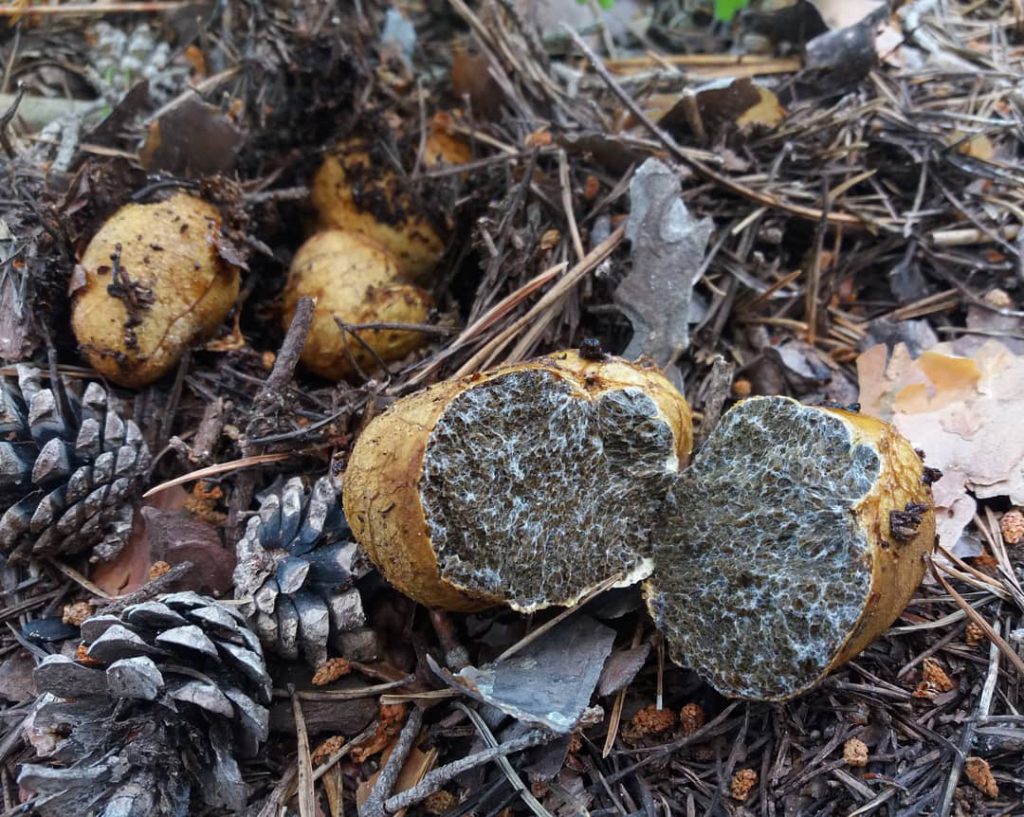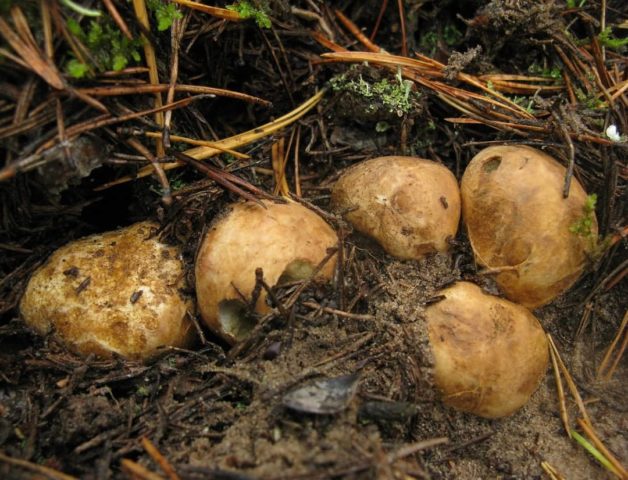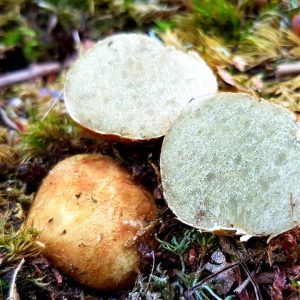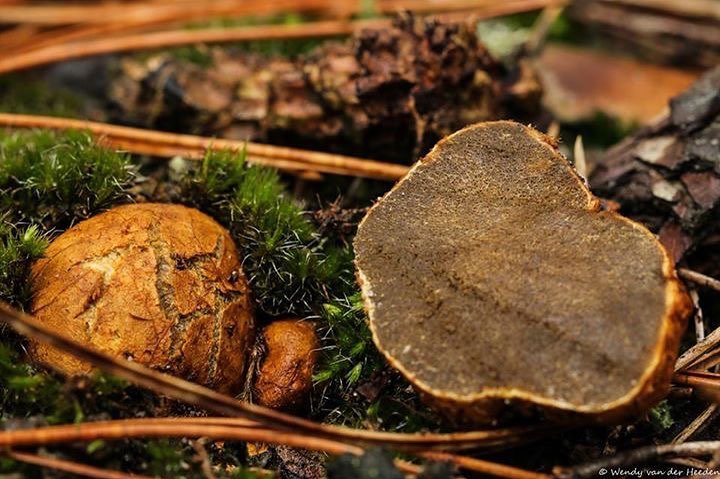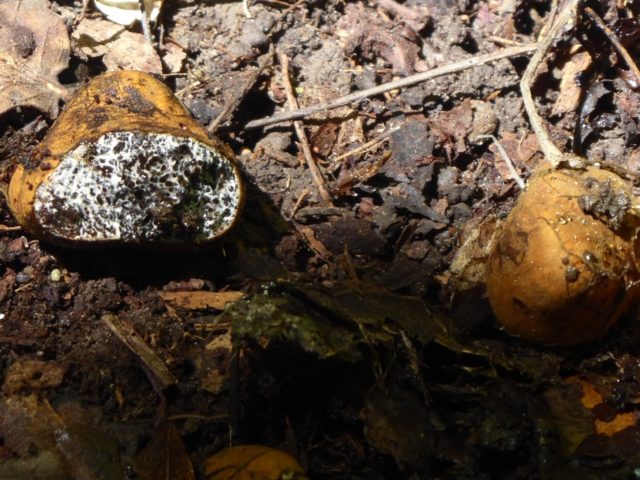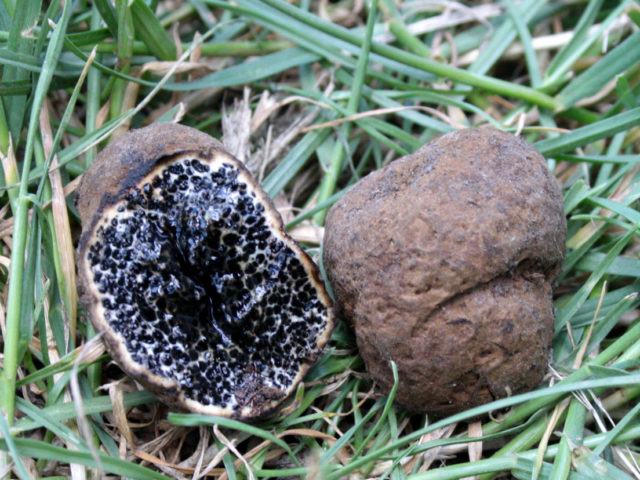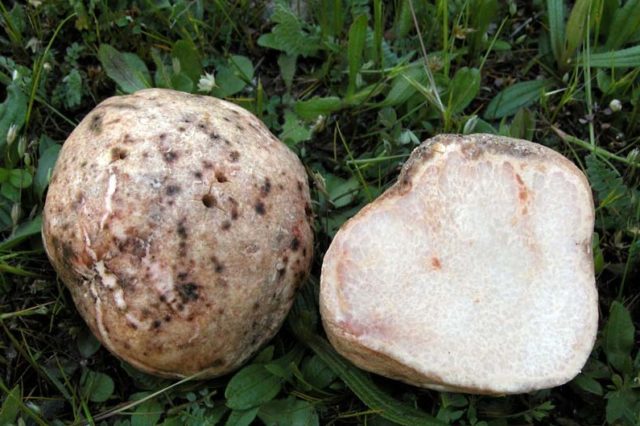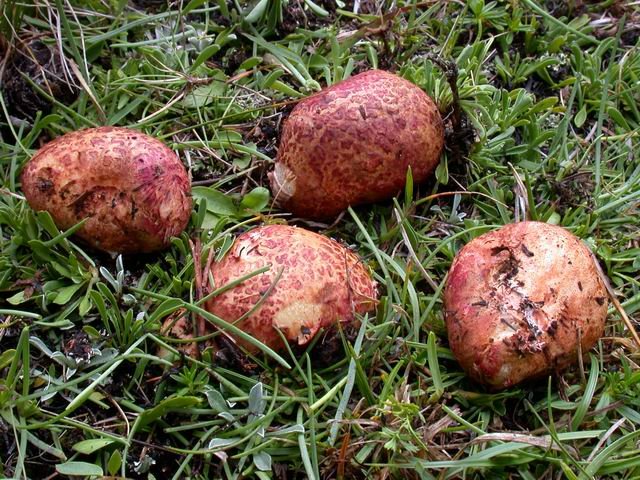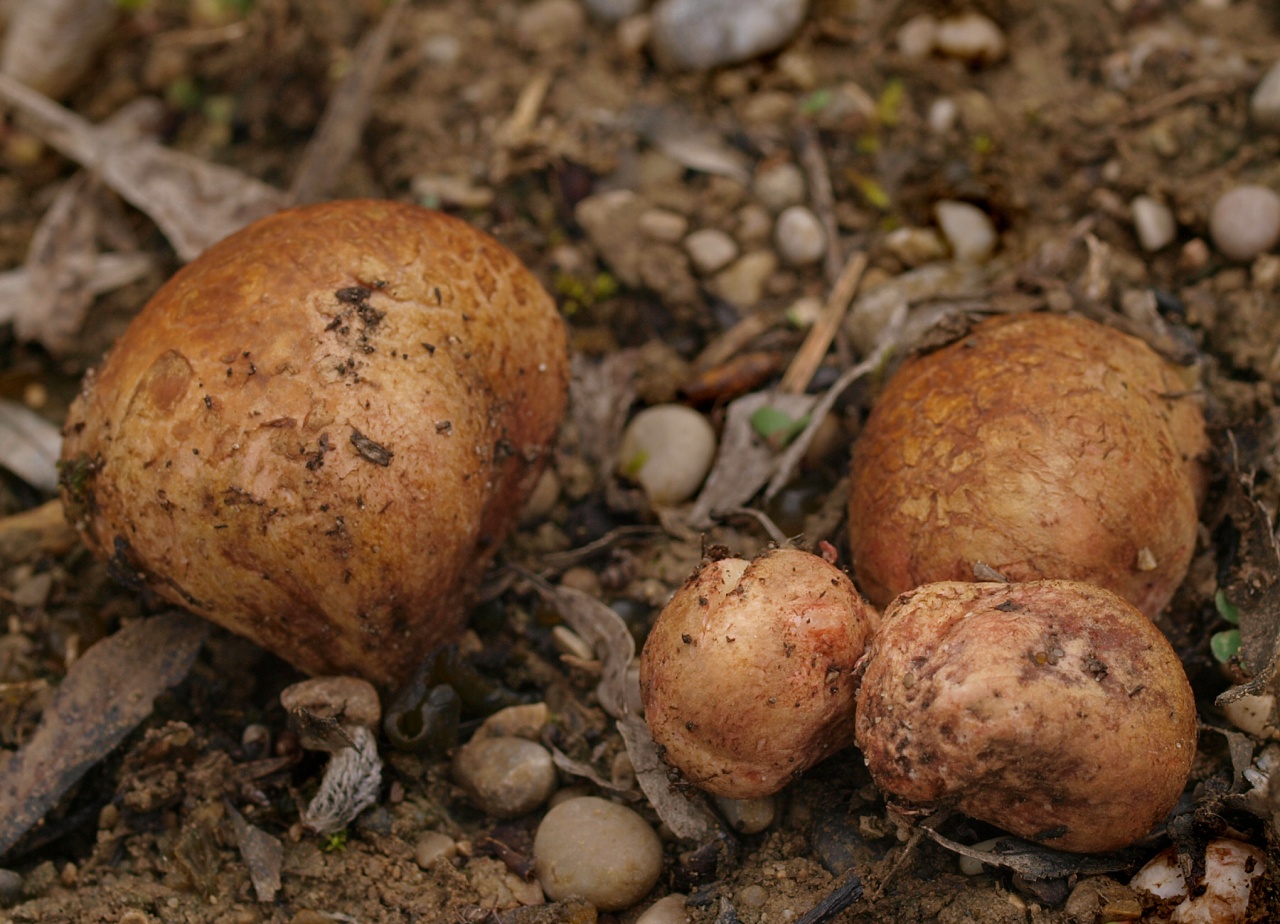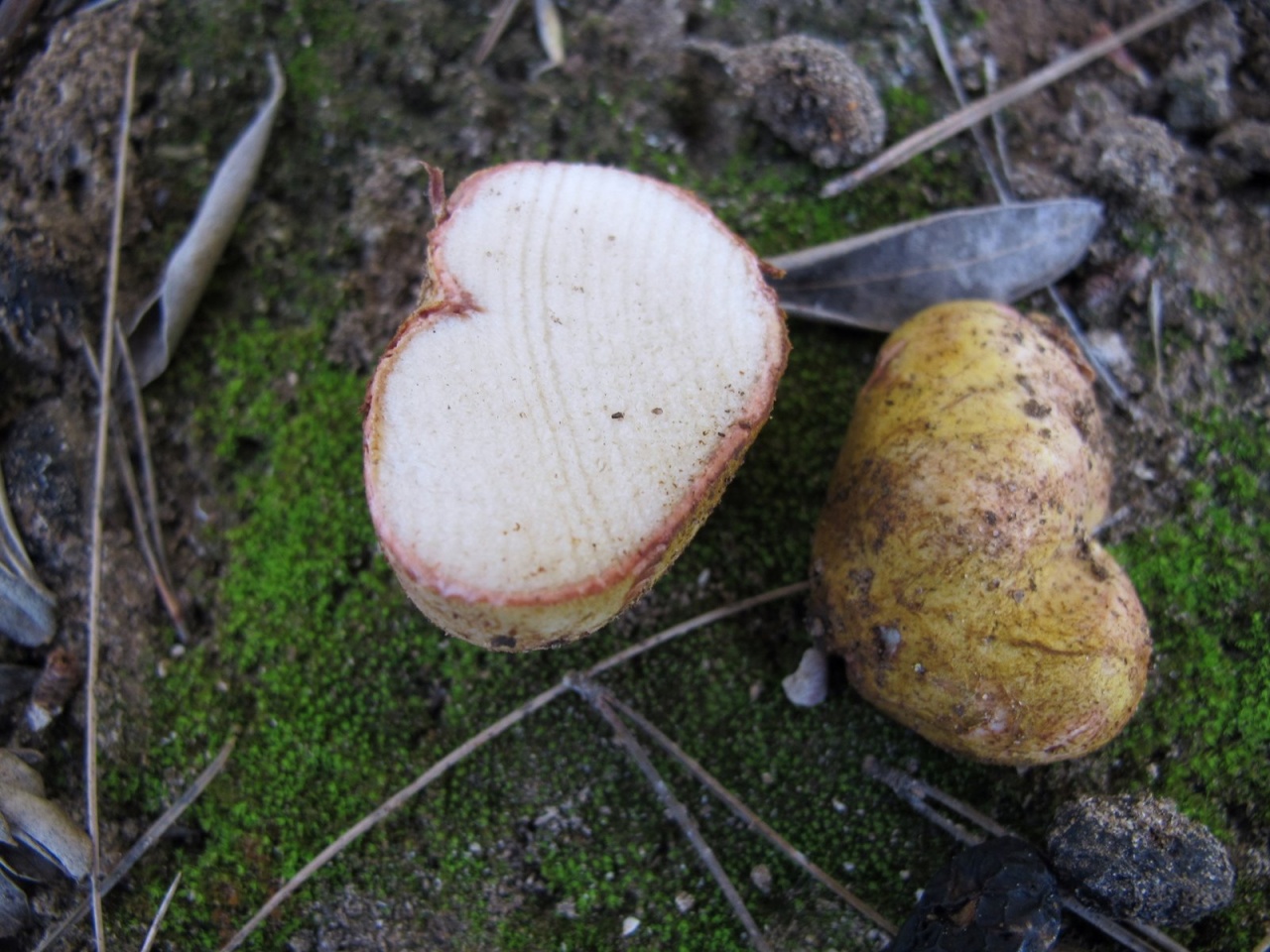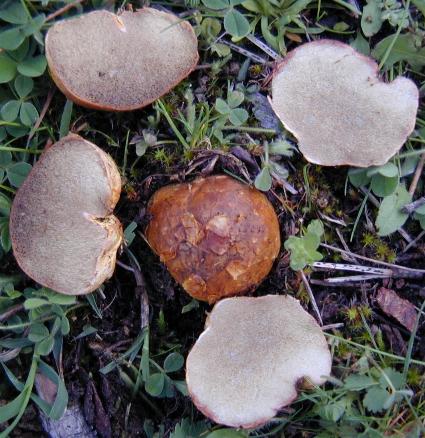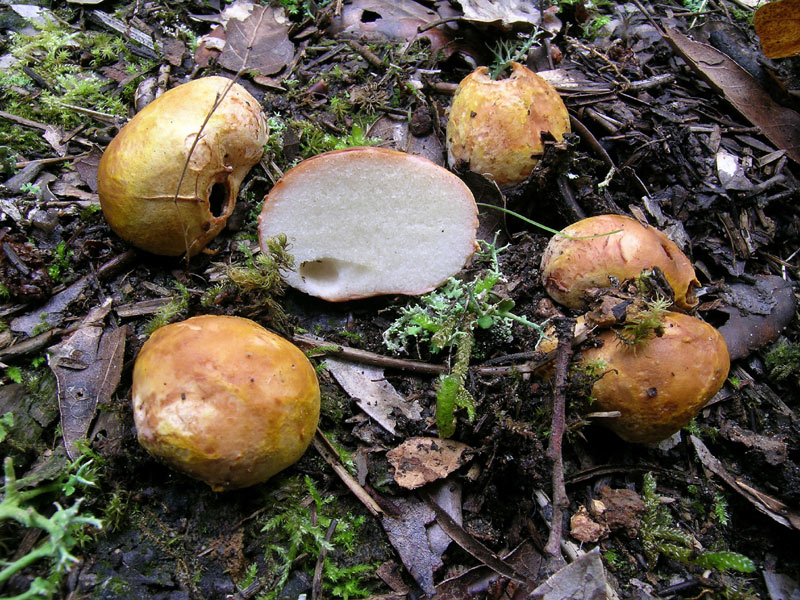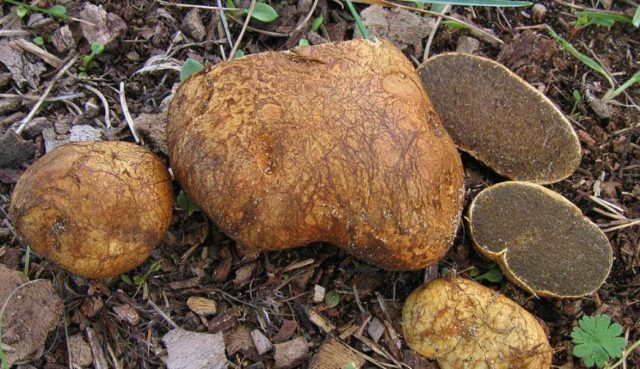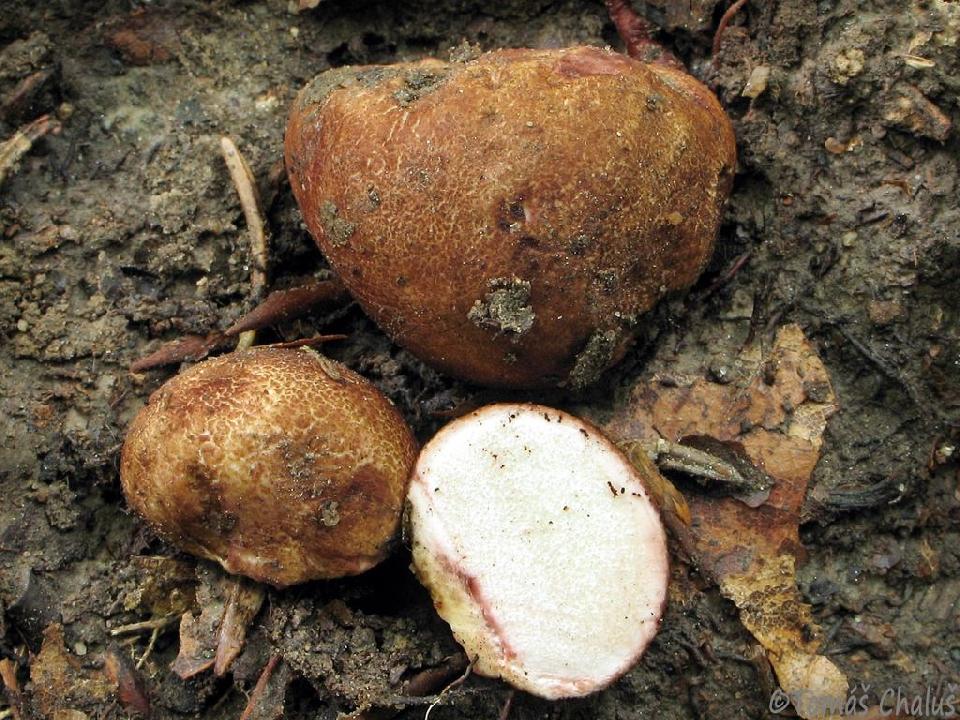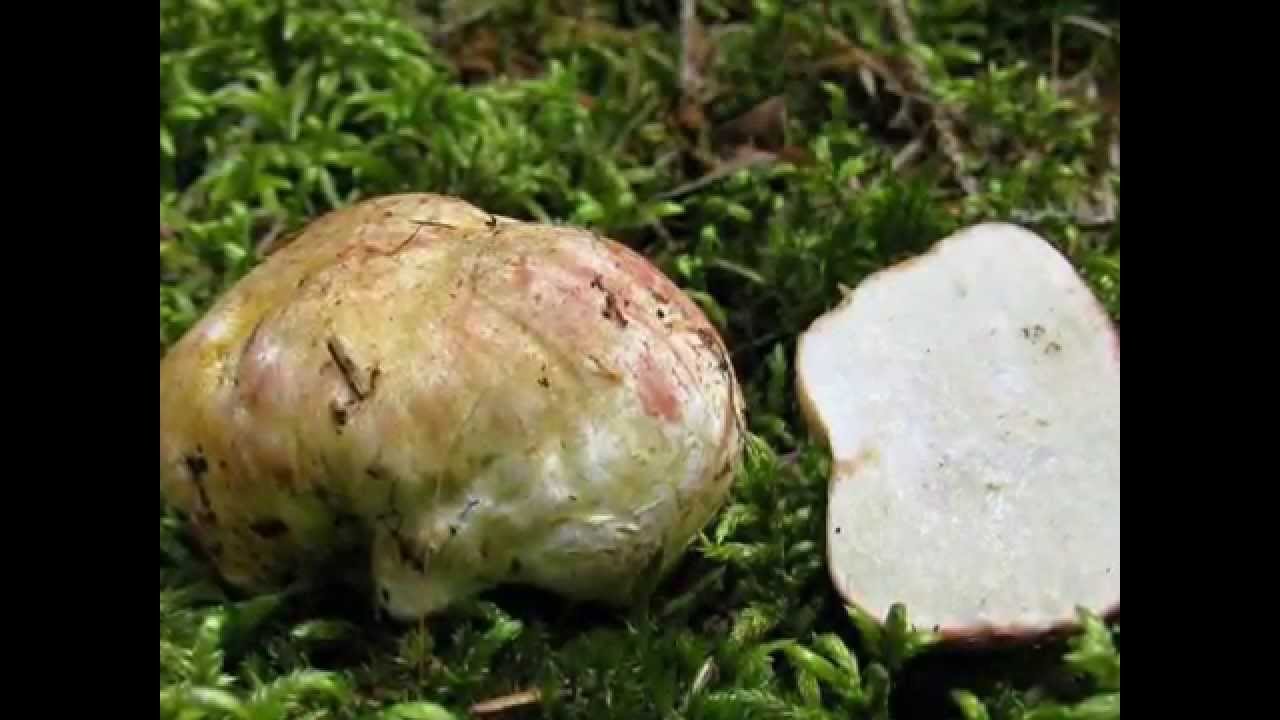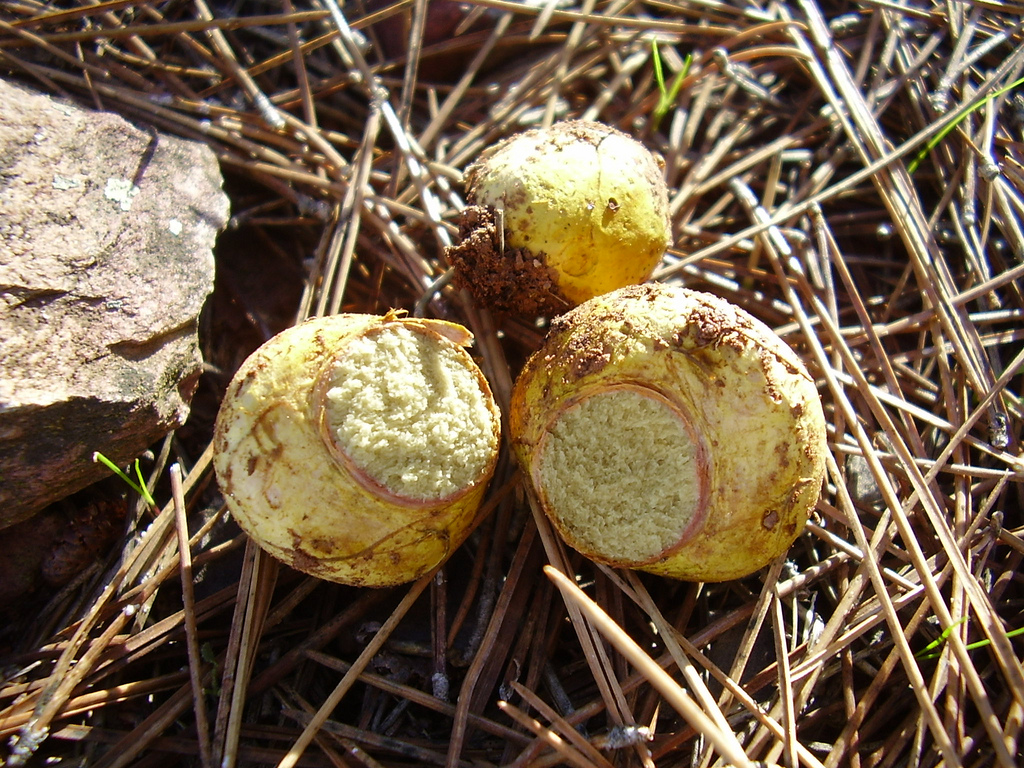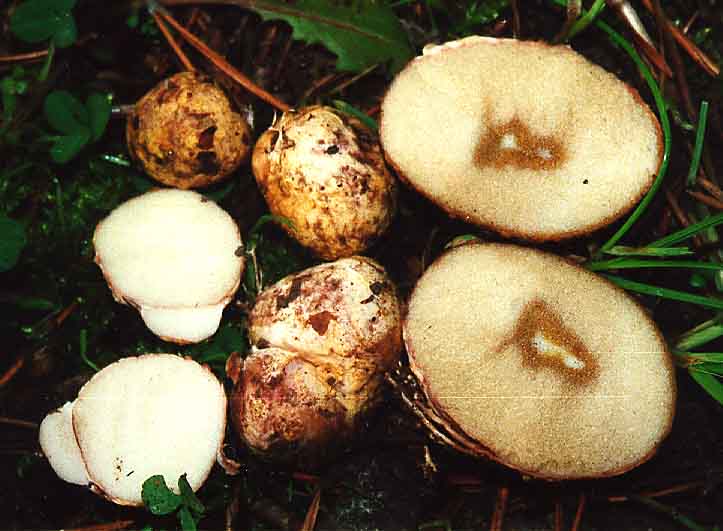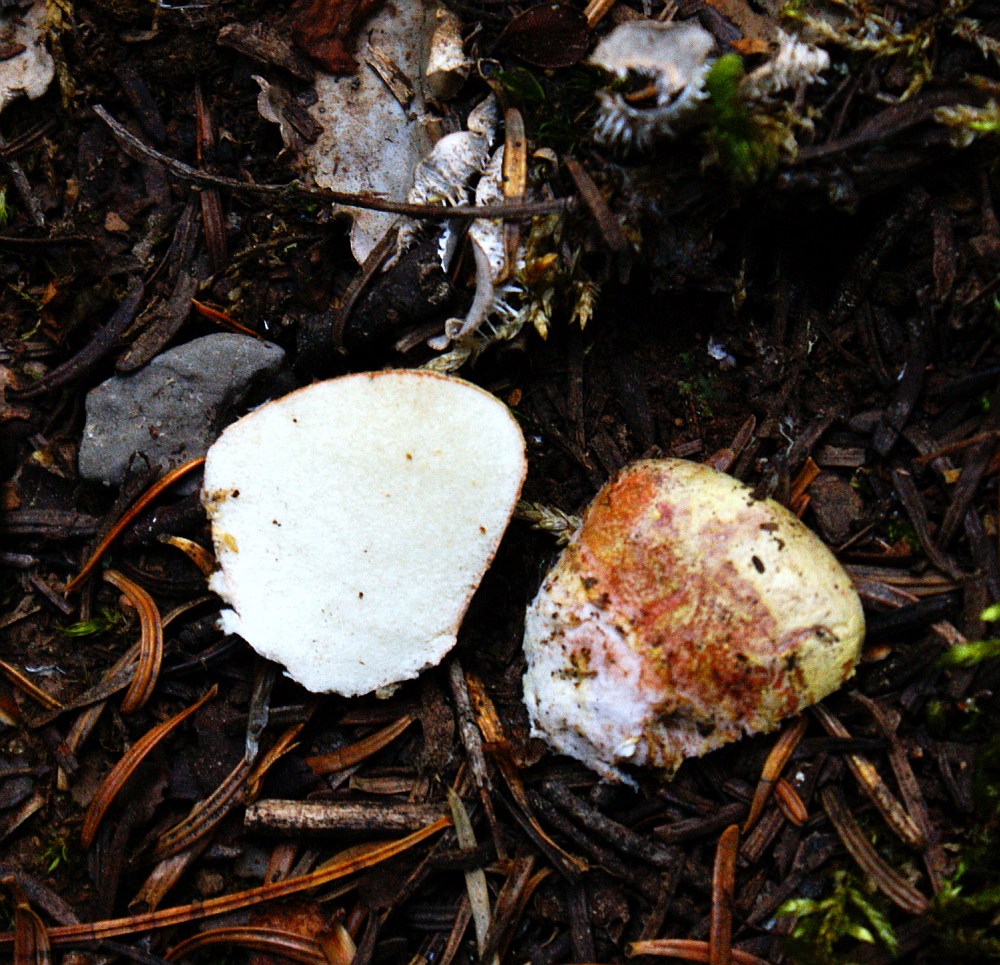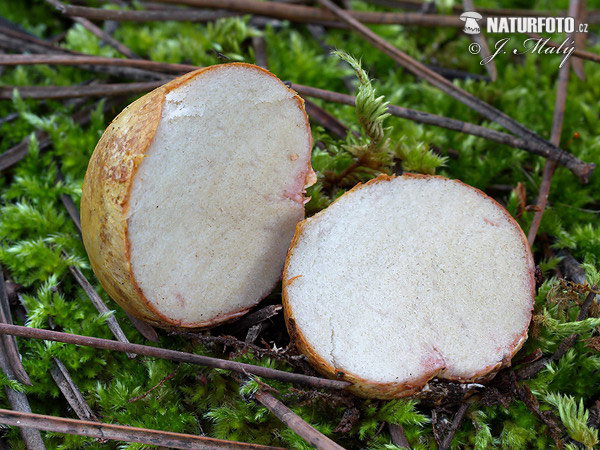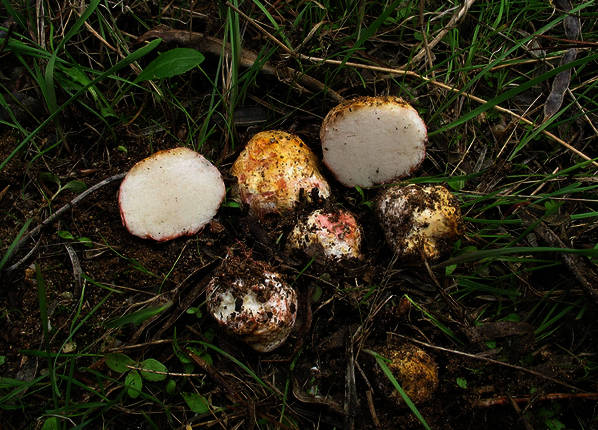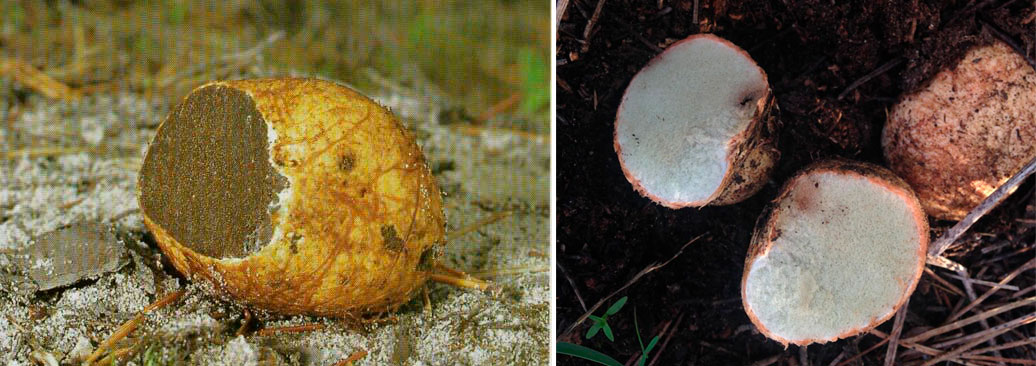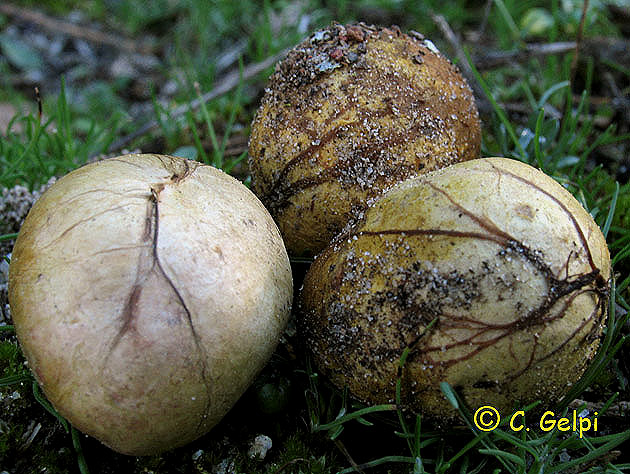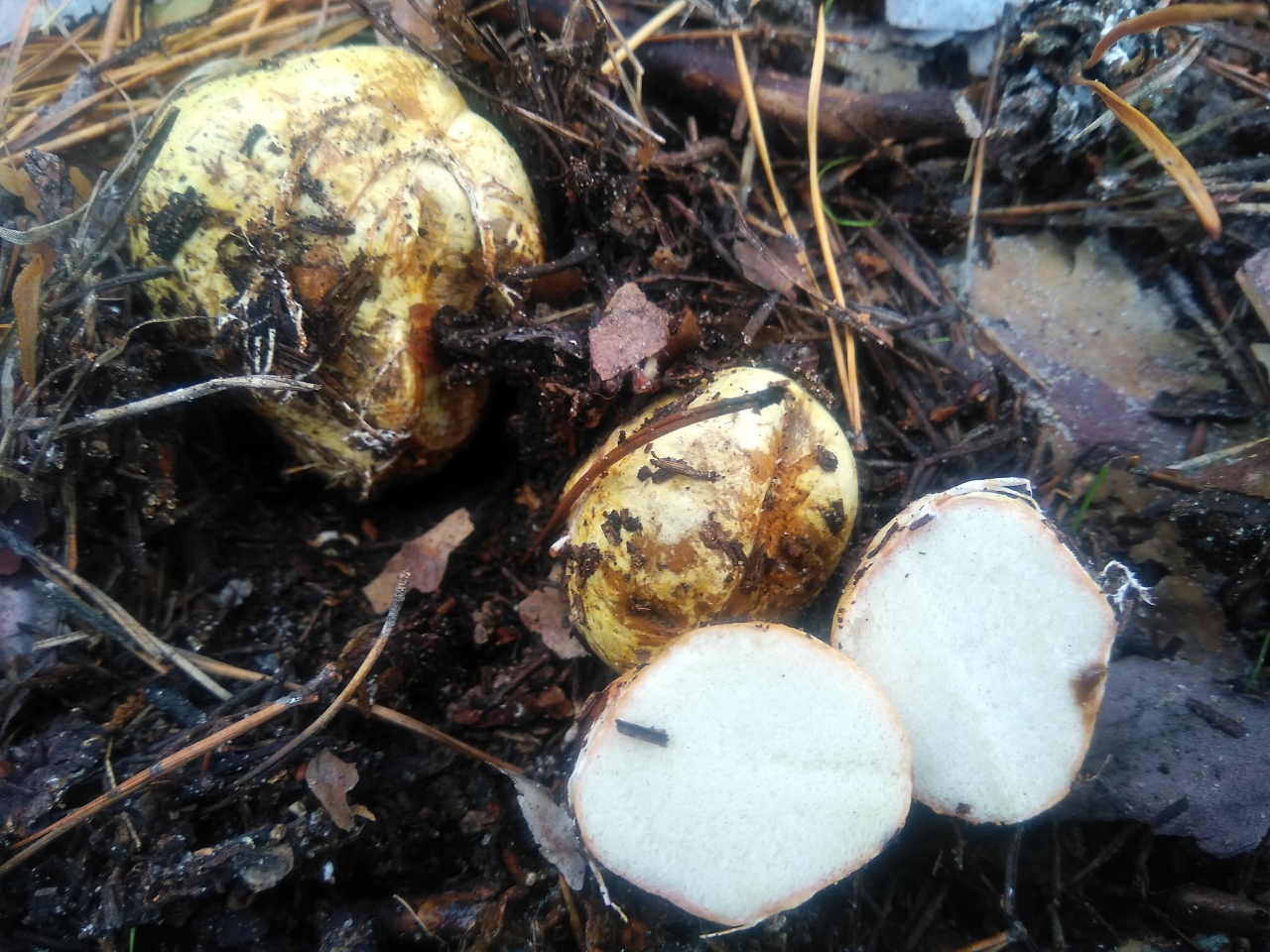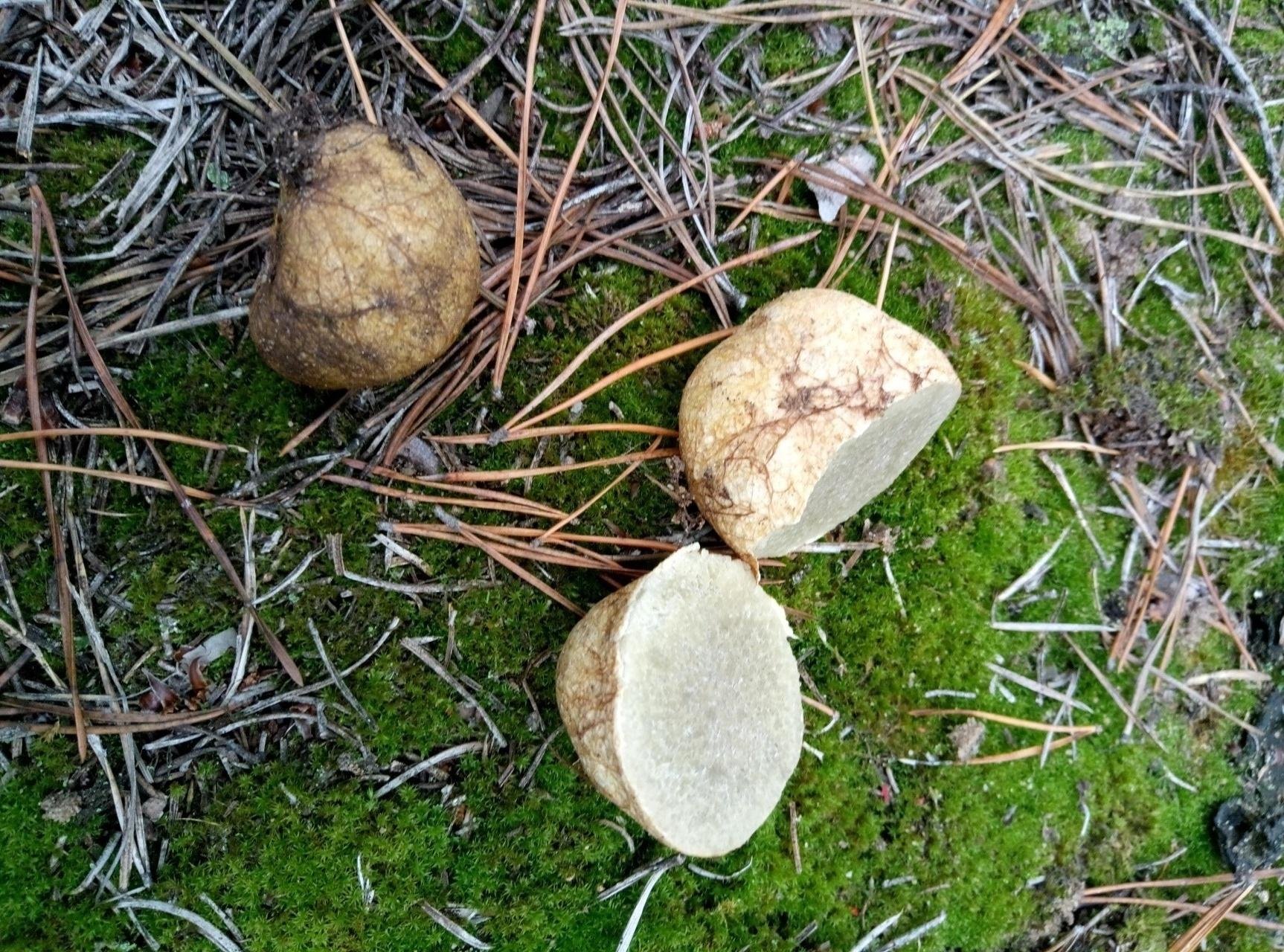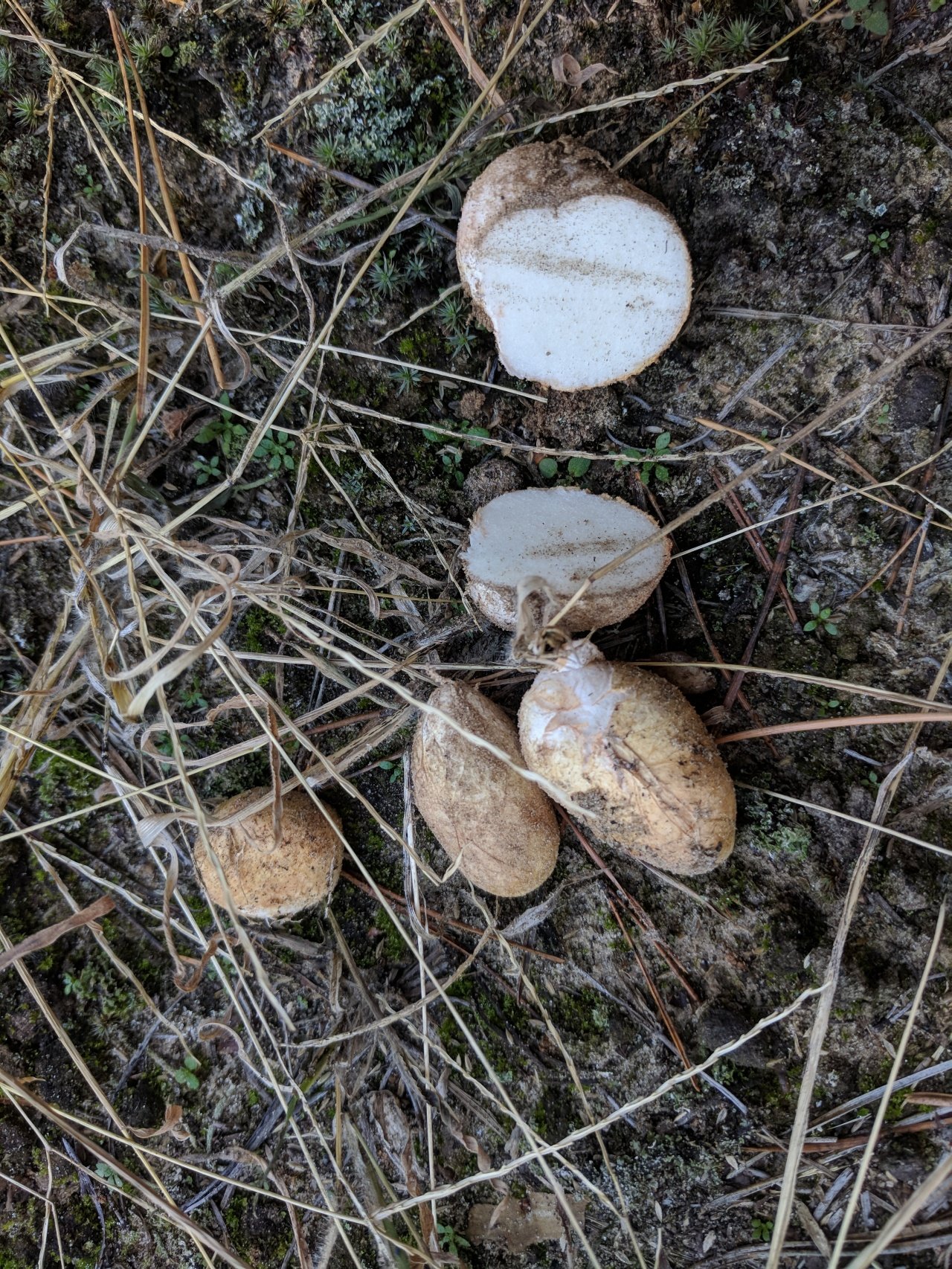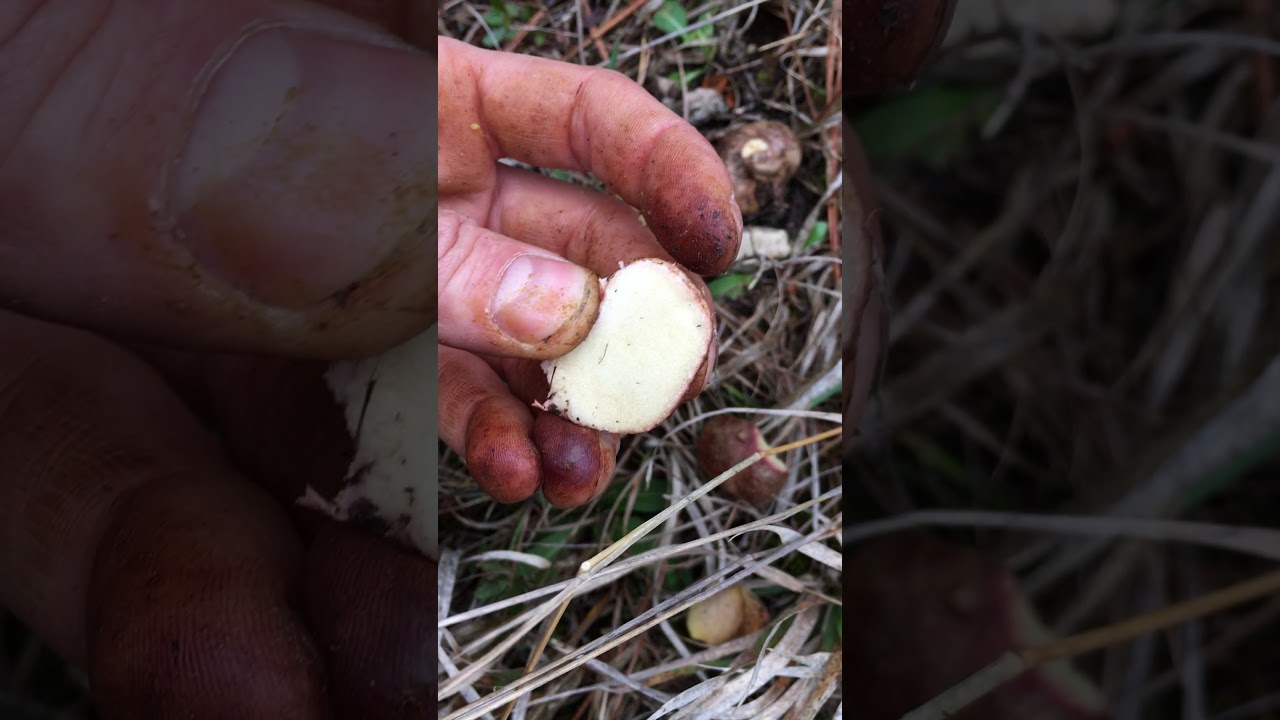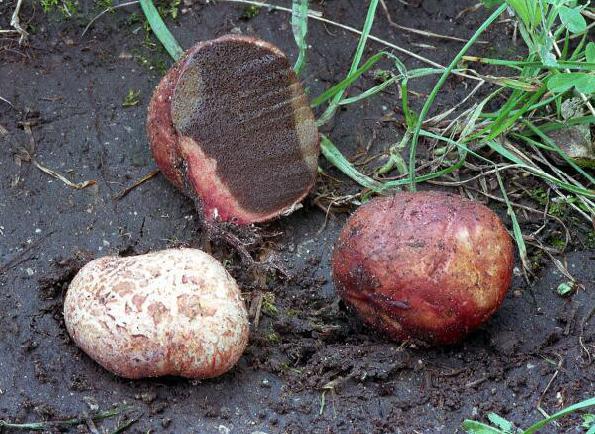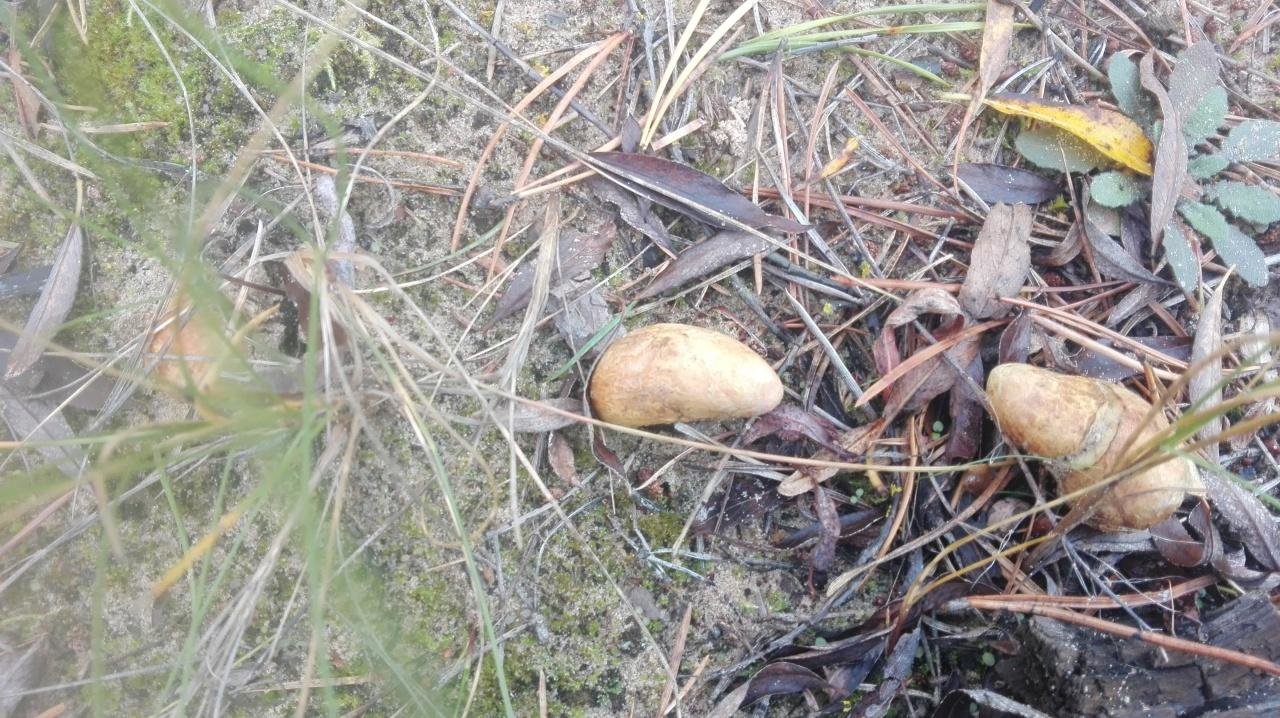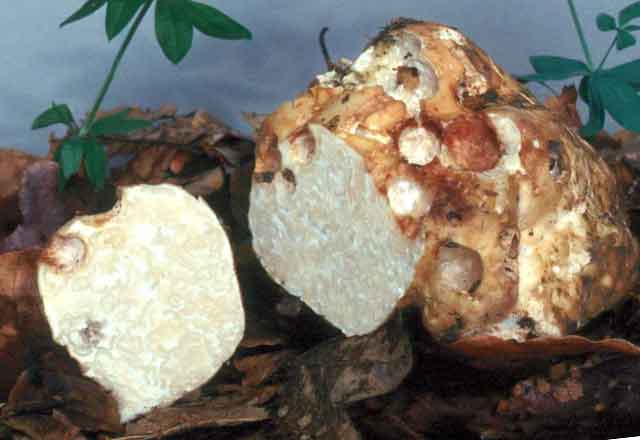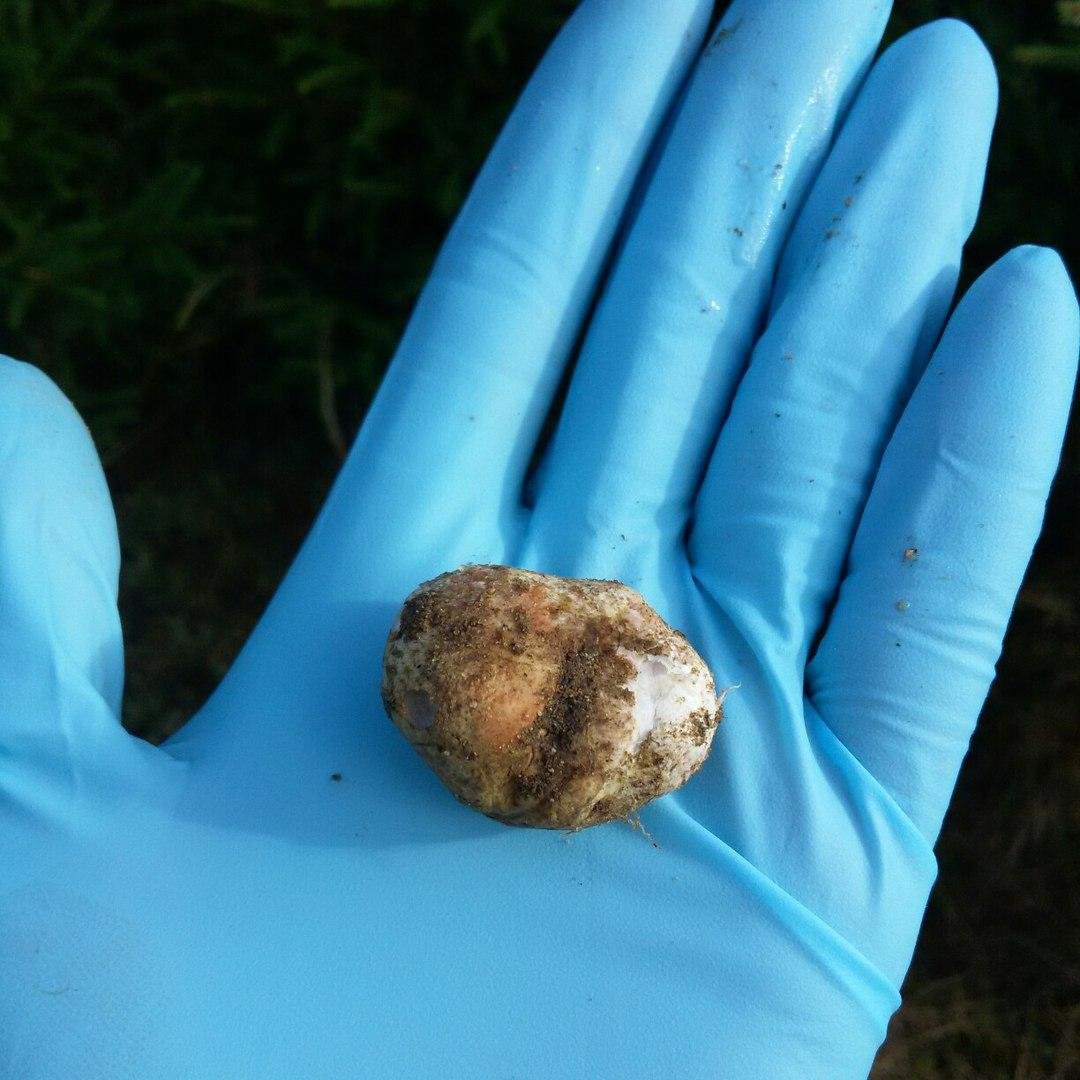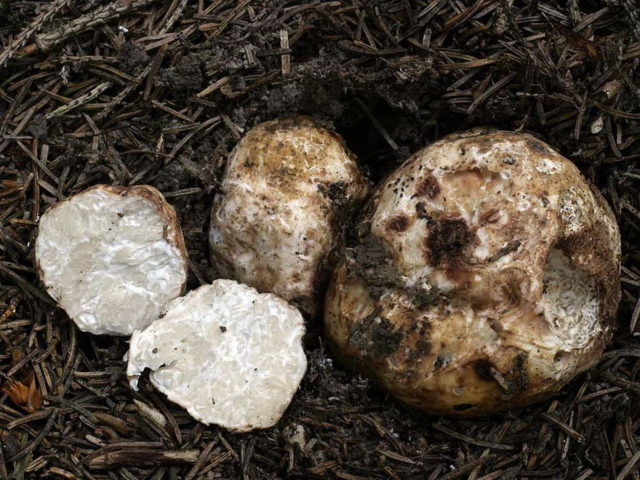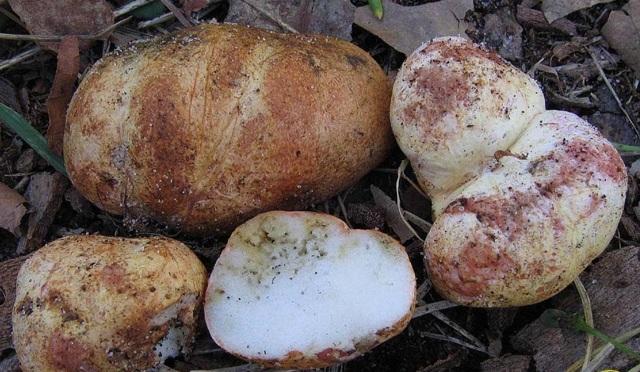False doubles
In appearance, common Rhizopogon is similar to the very rare Melanogaster ambiguus, a gasteromycete of the Pig family. Its fruiting body is represented not by a cap and a leg, but by an integral gastrocarp with a dense shell and a fruiting gleba. The surface of the mushroom is at first dull and velvety, colored in a gray-brown scale. As it matures, the peridium takes on a yellow-olive color with dark brown spots that resemble bruises. Old mushrooms are black-brown with a whitish coating.
Inside, the young melanogaster is whitish with blue-black chambers; in adulthood, the flesh darkens significantly, becoming red-brown or black with whitish veins. At the beginning of growth, the mushroom exudes a pleasant sweetish fruity aroma, but over time it is replaced by the fetid smell of dying onions or rubber. Information about the possibility of use is contradictory: some experts consider the mushroom edible at a young age, while others refer to the inedible species.
It is not surprising that common Rhizopogon is similar to other fungi of the genus Rhizopogon, in particular, yellowish Rhizopogon (Rhizopogon luteolus). The fungus is widespread in the temperate zone and in the north of Eurasia; it prefers light sandy soils of pine forests.
The surface of the fruit body at a young age is painted in a whitish-olive or light brown color, later darkens to brown-brown and cracks. The skin is entangled with brown-gray filaments of mycelium. The pulp is initially yellowish-white, with age it changes color to yellow-olive or greenish-brown. Old mushrooms are almost black inside. Rhizopogon yellowish is considered a conditionally edible product with low taste, when fried it looks like a raincoat.
Another double of the common rhizopogon is the pinkish rhizopogon (Rhizopogon roseolus), also called the pinkish or reddening truffle. The species is distinguished by a yellowish skin, which, when pressed, turns pink, like the flesh when cut or broken. The places and season of growth of the pinking truffle are identical to the common rhizopogon. The species is conditionally edible.
According to external data, common rhizopogon can be confused with an edible white truffle. The valuable counterpart also has a brownish color and tuberous shape, but it is more sinuous and coarse.
Rizopogon yellowish: what it looks like, where it grows, photo, is it possible to eat
Rhizopogon yellowish - a rare saprophyte mushroom, a relative of raincoats. Belongs to the class Agaricomycetes, family Rizopogonovye, genus Rizopogon. Another name for the mushroom is yellowish root, in Latin - Rhizopogon luteolus.
Where do yellowish rhizopogons grow
Rhizopogon luteolus is found throughout the temperate and northern latitudes of Eurasia. Grows in small groups mainly in pine forests on sandy and sub-sandy soils.
Forms mycorrhiza with conifers, most often with pines. It can be found in wooded summer cottages and parks. Loves loose soils with a high nitrogen content.
The fruiting body of the fungus is almost completely hidden underground or under a layer of fallen leaves, so it is not easy to find it.
What do yellowish rhizopogons look like?
Rhizopogon luteolus has a rather strange appearance for a fungus. He is missing a hat and a leg. The division of the fruiting body into upper and lower parts is rather arbitrary. Outwardly, it resembles a tuber of young potatoes. Has a size from 1 to 5 cm.
Young specimens are whitish-olive or light brown, mature ones are brown or brown. The surface of the fruiting body is dry. As it grows, its skin gradually cracks. The fruit body is entangled with gray-black filaments of the mycelium. Mature specimens have a pronounced garlic smell.
Spores are ellipsoidal, slightly asymmetric, shiny, smooth, transparent. The size of the spores is approximately 8 x 3 µm.
Taste qualities of the mushroom yellowish rhizopogon
Rhizopogon luteolus has a low taste. Despite the fact that it is considered edible.
Fried Rhizopogon tastes like a raincoat.
Benefits and harm to the body
Rhizopogon luteolus belongs to the fourth flavor category. The composition contains nutrients, but if used and prepared incorrectly, it is dangerous and can harm the body.
False doubles
Rhizopogon yellowish is similar in appearance to its relative - pinkish rhizopogon (Rhizopogon roseolus), another name for which is a blushing truffle or a turning pink truffle. This mushroom has a yellowish skin, if broken or cut, the flesh turns pink in this place.
The fruit body of a pinking truffle has a tuberous or irregularly rounded shape. Most of it is underground. The wall of the fruiting body is whitish or yellowish; when pressed, it becomes pinkish.
Rhizopogon pinkish edible, suitable for consumption only at a young age.
It is partially or completely hidden in the ground. The skin of a young mushroom is velvety; in a mature one, it becomes smooth and slightly cracks. Grows in spruce and pine forests, sometimes found in deciduous.
The harvesting season is from June to October. Never grows alone.
Rizopogon yellowish resembles dubious melanogaster (Melanogaster ambiguus). It is a very rare edible mushroom that grows singly in deciduous forests from May to October.
The pulp of the mushroom is purple-black, thick, fleshy, with a slight smell of garlic. Taste quality is low.
Collection rules
The harvesting season is from July to September. Rhizopogon luteolus is best harvested at the end of the season when it produces the highest yields.
Use
For eating, it is necessary to choose young specimens with a pleasant creamy pulp (old dark mushrooms cannot be used).
First, they must be rinsed under running water, carefully scrubbing each copy to remove the garlic taste and smell, then peel the thin skin.
Rhizopogon luteolus is prepared in the same way as raincoats, which are their closest relatives. All types of culinary processing are suitable for cooking - boiling, frying, stewing, baking, but they are most delicious when fried.
Attention! The mushroom can be dried, but only at a high temperature, otherwise it will germinate. Rhizopogon yellowish - a little-known species even among mushroom pickers
It is easy to confuse it with a white truffle, which is used by scammers selling it at a high price.
Rhizopogon yellowish - a little-known species even among mushroom pickers. It is easy to confuse it with a white truffle, which is used by scammers selling it at a high price.
The largest living organism on Earth is the mycelium
Finally, nothing living can match the size of mushrooms. In the US state of Oregon, there is a dark mushroom that extends over 10 square kilometers. Its age is from 1900 to 8650 years. However, despite its truly gigantic size, the mushroom was discovered only in the 21st century.
We see the mushrooms themselves only when the time for reproduction comes. If mushrooms were not sexually active, we might not even be aware of their existence.
Scientists were able to find out that mycelium mushrooms can reach such gigantic proportions only with the advent of DNA sequencing technology. After analyzing DNA samples from mushrooms in the area, scientists realized that all mushrooms are genetically identical.
Using the same method, researchers began to study colonies of microscopic fungi that live in soil and water, in plants and animals, and even in the air itself. The speed with which specialists are discovering all new types of fungi made them estimate the total number of these species on Earth at more than five million.
What other incredible feats are mushrooms that are not yet known to us?Systematics:
- Department: Basidiomycota (Basidiomycetes)
- Subdivision: Agaricomycotina
- Class: Agaricomycetes (Agaricomycetes)
- Subclass: Agaricomycetidae
- Order: Boletales
- Family: Rhizopogonaceae (Rhizopogonaceae)
- Genus: Rhizopogon
- View: Rhizopogon vulgaris (Rhizopogon common)
Other names for the mushroom:
Other names:
External description
The fruiting bodies of Rhizopogon vulgaris are tuberous or round (irregular) in shape. at the same time, only single strands of fungal mycelium can be seen on the surface of the soil, while the main part of the fruiting body develops underground. The diameter of the described fungus ranges from 1 to 5 cm. The surface of the common rhizopogon is characterized by a grayish-brown color. In ripe, old mushrooms, the color of the fruiting body may change, becoming olive-brown, with a yellowish tinge. In young mushrooms of common rhizopogon, the surface is velvety to the touch, and in old ones it becomes smooth. The inside of the mushroom is dense, oily and thick. At first, it has a light shade, but when mushroom spores mature, it becomes yellowish, sometimes brown-green.
The pulp of Rhizopogon vulgaris does not have any specific aroma and taste; it consists of a large number of special narrow chambers in which the spores of the fungus are located and mature. The lower region of the fruiting body contains small roots called rhizomorphs. They are white.
The spores of the fungus Rhizopogon vulgaris are characterized by an elliptical shape and a fusiform structure, smooth, with a yellowish tinge. A drop of oil can be seen along the edges of the spores.
Season and habitat of the mushroom
Common Rhizopogon (Rhizopogon vulgaris) is widespread in spruce, pine-oak and pine forests. You can also find this mushroom sometimes in deciduous or mixed forests. It grows mainly under conifers, pines and spruces. However, sometimes this type of mushroom can also be found under trees of other species (including deciduous ones). For its growth, Rhizopogon usually chooses soil or litter from fallen leaves. It is not found too often, it grows on the surface of the soil, but more often it is deeply buried inside it. Active fruiting and an increase in the yield of ordinary rhizopogon occurs during the period from June to October. It is almost impossible to see solitary mushrooms of this species, since Rhizopogon vulgaris grows only in small groups.
Edibility
Rhizopogon ordinary belongs to the poorly studied mushrooms, but it is considered edible. Mycologists recommend eating only the young fruiting bodies of Rhizopogon vulgaris.
Similar types and differences from them
Common Rhizopogon (Rhizopogon vulgaris) is very similar in appearance to another mushroom of the same genus, which bears the name. True, in the latter, with damage and strong pressure, the pulp turns red, and the color of the outer surface of the fruiting body is white (in mature mushrooms it becomes olive-brown or yellowish).
Mushrooms gave man alcohol
It is impossible to write an ode to mushrooms without starting with alcohol.
One of the groups of fungi - yeast - generates energy during fermentation, the by-products of which are carbon dioxide and alcohol.
For most microorganisms, alcohol is a poison, but yeast has managed to develop a tolerance for high degrees in the process of evolution.
Mankind learned to appreciate the nutrient-rich and bacteria-free drinks about 10 thousand years ago, long before the invention of pasteurization and refrigerators. Some scientists, in particular biomolecular archaeologist Patrick McGovern, even believe that our ancestors began to grow and store crops not because they needed more bread, but for the sake of alcohol.
McGovern is the Science Director of the Biomolecular Archaeological Project on Culinary, Fermented Drinks and Healthcare at the University of Pennsylvania Museum in the United States. He found that an obsessive interest in alcohol appeared in a person much earlier than is commonly believed. The scientist sequenced the DNA of yeast from ancient Egyptian wine vessels, which are more than 5 thousand years old (this yeast turned out to be the ancestors of the modern fermentation yeast Saccharomyces cerevisiae).In China, McGovern found evidence that people produced alcohol even earlier - more than 9 thousand years ago, that is, long before the invention of the wheel. These were the priorities.
Mushrooms spawn zombies
The wind is something else. Some mushrooms can create a real walking nightmare.
Fungi of the species Ophiocodyceps, which live in rainforests, inhabit the brains of carpenter ants. The Thai mushroom Ophiocordyceps unilateralis causes the ant to move erratically, causing the insect to fall from the foliage to the ground. After that, the mushroom tells the ant to climb the tree trunk to a height of a little less than a meter - that is, where conditions are ideal for the growth of the fungus in terms of temperature and humidity.
He controls not only the height to which the ant rises, but also the direction - usually it is north-north-west. Usually, ants do not chew leaves from a tree, but insects infected with fungi begin to gnaw them. Moreover, zombie ants begin to eat leaves at exactly noon - a fact worthy of science fiction.
In this unusual position, the ant dies. In rigor mortis, the insect's jaws continue to grip the leaf, as the ant's muscles atrophy due to the fungus growing through its head. The body remains in this position for up to two weeks. The fungus, meanwhile, prepares to breed. Finally, he showered his spores on healthy ants, which, without suspecting anything, continue to get food in order to carry it to their nests in the tree crown.
The cycle of zombification repeats itself.
This type of mushroom has honed its zombification skills to the highest level. It inspired filmmakers and video games, and launched a crowdfunding campaign to find the genes responsible for controlling the ant.
Who doesn't love zombie stories?
Mushrooms are faster than bullets
When it comes to the speed of exposing offspring from home, mushrooms are second to none among living organisms.
Spores of the dung fungus Pilobolus crystallinus fly faster than bullets and any living organisms on our planet.
In appearance, Pilobolus does not look like an ordinary mushroom. It resembles a tiny transparent snake with a bowler hat on its head. This hat is a bag of spores, and the mushroom can shoot it, and the maximum speed of the bag of spores can reach 25 meters per second, and the acceleration is 1.7 million meters per second squared. For comparison, the American rocket "Saturn-5", which was used to launch the second lunar mission "Apollo-8", accelerated no faster than 40 meters per second squared.
Image copyright Jason Hollinger CC by 2.0 Image caption This mushroom has 28,000 gender variants
It is not surprising that in the English-speaking world this mushroom is called the "hat-launcher".
If you want to compare this dung cannon to a firearm, here's a great storyline from Earth Unplugged.
Spoiler alert: Yes, Pilobolus spores fly faster than bullets and shot.
Rizopogon pinkish: what it looks like, where it grows, is it possible to eat it, cooking
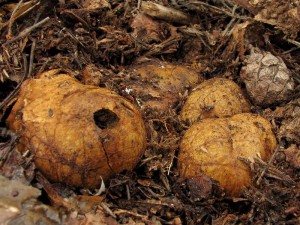
The fruit body is tuberous, underground, outwardly similar to young potatoes, with a diameter of 1 to 5 centimeters. Its surface is dry, in mature specimens the skin is cracked, has a color from yellow-brown to brown (in old mushrooms); covered from above with branched brown-black filaments of mycelium. The peel has a specific garlic odor, but it can be removed well under a stream of water with increased friction. The pulp is dense, thick, fleshy, at first white with an olive tint, later brown-green, in mature specimens it is almost black, without a pronounced taste and aroma. Spores are smooth, shiny, almost colorless, ellipsoidal with slight asymmetry, 7-8 X 2-3 microns.
It grows from early July to late September on sandy and sub-sandy soils (for example, on paths) in pine forests. Massively bears fruit at the end of the warm season. It thrives on nitrogen-rich soils.
The yellowish root can be confused with the dubious melanogaster, although it is not common in our forests.Yellowish Rizopogon is similar to pinkish Rizopogon (Red Truffle), from which it differs in skin color, and the flesh of the second, when interacting with air, quickly turns red, which justifies its name.
Little known mushroom, but edible. Although it does not possess high taste. Only young individuals are used for food, until the pulp has darkened (if the pulp has already darkened or turned green on the cut, they do not eat the mushroom). It can be boiled, but it is usually eaten fried, then it tastes similar to raincoats. It is necessary to dry this mushroom at high temperatures, since this mushroom tends to germinate with a long stagnation.
-> Category: Edible mushrooms | -> Added by: 162nord
-> Views: 18111 | -> Downloads: | -> Rating: 4.7 / 3
The largest living organism on Earth is the mycelium
Finally, nothing living can match the size of mushrooms. In the US state of Oregon, there is a dark mushroom that extends over 10 square kilometers. Its age is from 1900 to 8650 years. However, despite its truly gigantic size, the mushroom was discovered only in the 21st century.
We see the mushrooms themselves only when the time for reproduction comes. If mushrooms were not sexually active, we might not even be aware of their existence.
Scientists were able to find out that mycelium mushrooms can reach such gigantic proportions only with the advent of DNA sequencing technology. After analyzing DNA samples from mushrooms in the area, scientists realized that all mushrooms are genetically identical.
Using the same method, researchers began to study colonies of microscopic fungi that live in soil and water, in plants and animals, and even in the air itself. The speed with which specialists are discovering all new types of fungi made them estimate the total number of these species on Earth at more than five million.
What other incredible feats are mushrooms that are not yet known to us?Systematics:
- Department: Basidiomycota (Basidiomycetes)
- Subdivision: Agaricomycotina
- Class: Agaricomycetes (Agaricomycetes)
- Subclass: Agaricomycetidae
- Order: Boletales
- Family: Rhizopogonaceae (Rhizopogonaceae)
- Genus: Rhizopogon
- View: Rhizopogon vulgaris (Rhizopogon common)
Other names for the mushroom:
Other names:
External description
The fruiting bodies of Rhizopogon vulgaris are tuberous or round (irregular) in shape. at the same time, only single strands of fungal mycelium can be seen on the surface of the soil, while the main part of the fruiting body develops underground. The diameter of the described fungus ranges from 1 to 5 cm. The surface of the common rhizopogon is characterized by a grayish-brown color. In ripe, old mushrooms, the color of the fruiting body may change, becoming olive-brown, with a yellowish tinge. In young mushrooms of common rhizopogon, the surface is velvety to the touch, and in old ones it becomes smooth. The inside of the mushroom is dense, oily and thick. At first, it has a light shade, but when mushroom spores mature, it becomes yellowish, sometimes brown-green.
The pulp of Rhizopogon vulgaris does not have any specific aroma and taste; it consists of a large number of special narrow chambers in which the spores of the fungus are located and mature. The lower region of the fruiting body contains small roots called rhizomorphs. They are white.
The spores of the fungus Rhizopogon vulgaris are characterized by an elliptical shape and a fusiform structure, smooth, with a yellowish tinge. A drop of oil can be seen along the edges of the spores.
Season and habitat of the mushroom
Common Rhizopogon (Rhizopogon vulgaris) is widespread in spruce, pine-oak and pine forests. You can also find this mushroom sometimes in deciduous or mixed forests. It grows mainly under conifers, pines and spruces. However, sometimes this type of mushroom can also be found under trees of other species (including deciduous ones). For its growth, Rhizopogon usually chooses soil or litter from fallen leaves.It is not found too often, it grows on the surface of the soil, but more often it is deeply buried inside it. Active fruiting and an increase in the yield of ordinary rhizopogon occurs during the period from June to October. It is almost impossible to see solitary mushrooms of this species, since Rhizopogon vulgaris grows only in small groups.
Edibility
Rhizopogon ordinary belongs to the poorly studied mushrooms, but it is considered edible. Mycologists recommend eating only the young fruiting bodies of Rhizopogon vulgaris.
Similar types and differences from them
Common Rhizopogon (Rhizopogon vulgaris) is very similar in appearance to another mushroom of the same genus, which bears the name. True, in the latter, with damage and strong pressure, the pulp turns red, and the color of the outer surface of the fruiting body is white (in mature mushrooms it becomes olive-brown or yellowish).
Where do common rhizopogons grow
Common Rhizopogon is a poorly studied mushroom that is rarely found in the forest. The finding of this species is an infrequent occurrence, because the fruiting bodies are almost completely hidden under the soil layer. But if one is found, others will surely be found nearby - Rhizopogoni never grow alone.
Common Rhizopogon settles in spruce and pine forests, less often in mixed forests. Mushrooms grow in the soil under fallen leaves in the immediate vicinity of coniferous tree trunks. Only single mycelial strands can be seen on the surface. Sometimes there are surface specimens, but for the most part the fruit body of the common rhizopogon is deeply buried in the ground. The active fruiting season is from June to October.
Mushroom wind
In addition to producing insane amounts of yeast, mushrooms can also induce wind.
In a way, a mushroom is like a fruit hanging from a tree. The cap of a mushroom is full of spores, like a fruit is full of seeds. However, unlike a tree, most of the fungus is hidden underground. The mycelium forms a network that connects the mushrooms on the surface.
Image copyright Thinkstock Image caption Mold is also a mushroom
Fungi need their spores to spread as far as possible; then the offspring will not compete with their "parents" for nutritional resources. At the same time, mushrooms cannot count on the help of animals in traveling long distances. They have to rely on themselves and use the available resources. The main one is water.
When it comes time to spray the spores, the mushrooms release water vapor, thus cooling the air around them. The air currents create a lift that can carry spores up to 10 centimeters in all directions.



